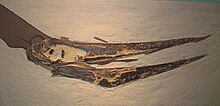Pteranodontia
| Pteranodontians | |
|---|---|

| |
| Skull specimen (AMNH 7515) of the Pteranodon longiceps
| |

| |
| Skull cast of the Nyctosaurus gracilis
| |
| Scientific classification | |
| Domain: | Eukaryota |
| Kingdom: | Animalia |
| Phylum: | Chordata |
| Order: | †Pterosauria |
| Suborder: | †Pterodactyloidea |
| Clade: | †Pteranodontoidea |
| Clade: | †Pteranodontia Marsh, 1887 |
| Subgroups | |
| |
| Synonyms | |
| |
Pteranodontia is an extinct group of
Classification
Pteranodontia was originally named by Marsh in 1876. In 2003, it was given a
Below is a cladogram showing the phylogenetic placement of this group from Andres and Myers (2013).[2]
| Pteranodontia |
| |||||||||||||||||||||||||||||||||||||||||||||||||||||||||||||||||||||||||||||||||||||||||||||||||||||||||||||||||||||||||||||||||||||||||||||
In 2018, Longrich, Martill, and Andres revisited the classification and proposed a different hypothesis based on a new phylogenetic analysis. Following Marsh's original classification, they restricted Pteranodontia to the families Pteranodontidae and Nyctosauridae. They also replaced Pteranodontia with Pteranodontoidea as the more inclusive group.[3]
| Ornithocheiroidea |
| |||||||||||||||||||||||||||||||||||||||||||||||||||||||||||||||||||||||||||||||||||||||||||||||||||||||||
In 2022, Fernandes et al. described Epapatelo as a new pteranodontian from Angola. Including Epapatelo in the phylogenetic analysis of Longrich et al. (2018), they recovered a new clade, Aponyctosauria, composed of the Nyctosauridae, Alcione, Simurghia, and Epapatelo.[4]
| Pteranodontia |
| |||||||||||||||||||||||||||||||||||||||||||||||||||||||||||||||
Paleobiology
Locomotion
Similar to other pterosaurs, pteranodontian are considered to have been skilled fliers as well as adept at moving on the ground. Evidence from footprints shows that most pterosaurs did not sprawl their limbs to a large degree, as in modern reptiles, but rather held the limbs relatively erect when walking, like dinosaurs. Footprints of pteranodontians are still unknown, but it is likely that they also walked erect.[5] Among pterosaurs, pteranodontians had unusually uneven limb proportions, with the forelimbs much larger and longer than the hind limbs. This would likely have required them to use unique modes of locomotion when on the ground compared to other pterosaurs. Most pteranodontians like Pteranodon flew like modern day albatrosses, which consists of flying very long distances and rarely flapping,[6][7] though they were thermal soarers like continental flyers rather than dynamic soarers like most seabirds.[8]
"Wyomingopteryx"
The name "Wyomingopteryx" appears in a painting of Morrison prehistoric animals by
References
- S2CID 205783384.
- S2CID 84617119.
- hdl:10362/145845.
- PMID 21085624.
- ^ Habib, M. (2011). "Dinosaur Revolution: Anhanguera." H2VP: Paleobiomechanics. Weblog entry, 20-SEP-2011. Accessed 28-SEP-2011: http://h2vp.blogspot.com/2011/09/dinosaur-revolution-anhanguera.html
- ISBN 978-0691150611.
- ^ Goto, Yusuke; Yoda, Ken; Weimerskirch, Henri; Sato, Katsufumi (2020). "Soaring styles of extinct giant birds and pterosaurs". bioRxiv. doi:10.1101/2020.10.31.354605. S2CID 226263538.
- ISBN 0-7166-0595-3.
- ^ Bakker, R.T. (1998). "Dinosaur mid-life crisis: the Jurassic-Cretaceous transition in Wyoming and Colorado". In Lucas, Spencer G.; Kirkland, James I.; Estep, J.W. Lower and Middle Cretaceous Terrestrial Ecosystems 14. New Mexico Museum of Natural History and Science Bulletin. pp. 67–77.
